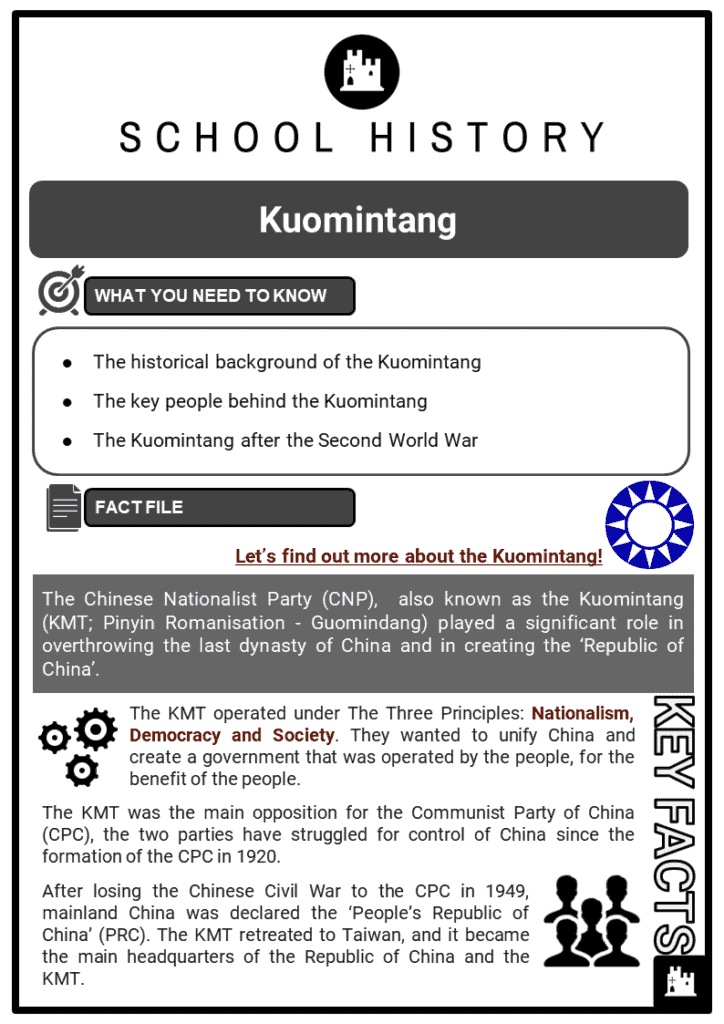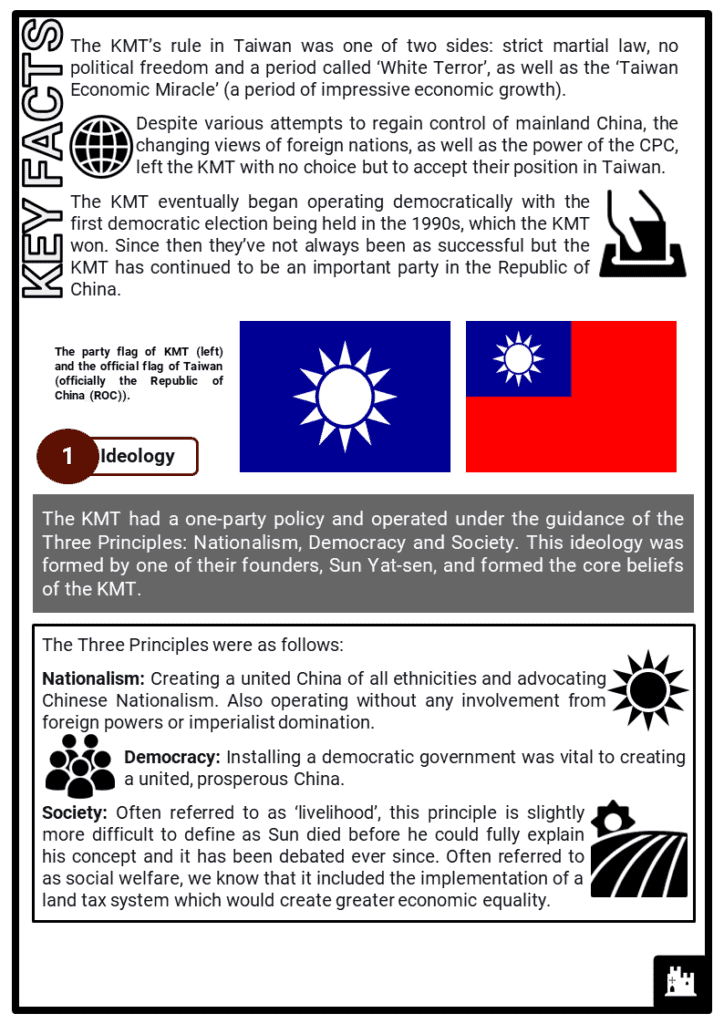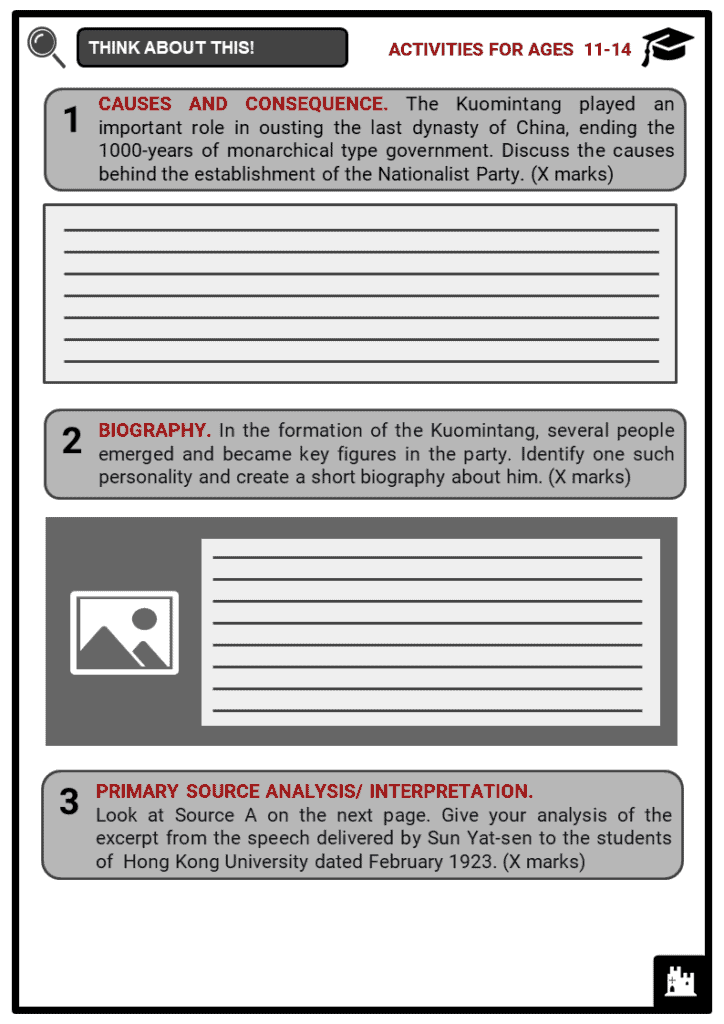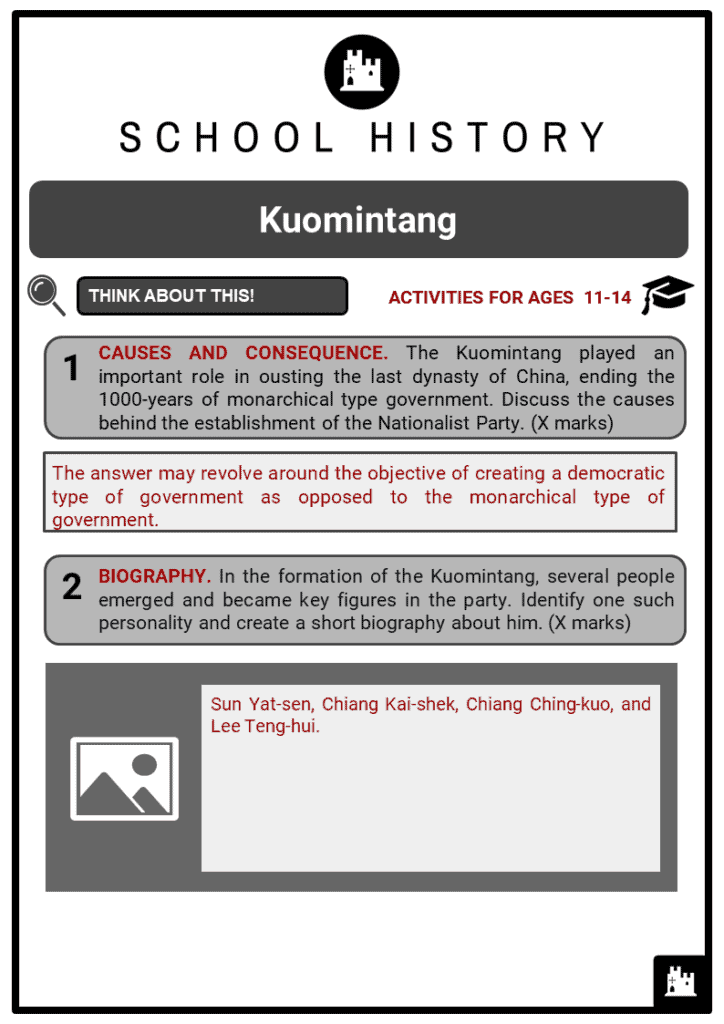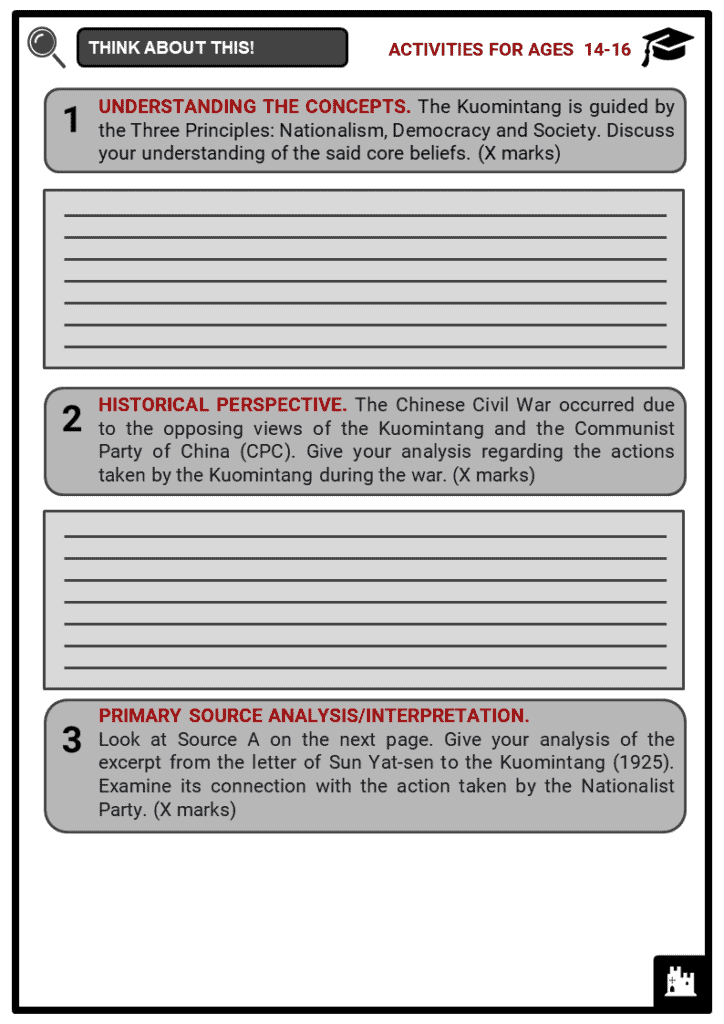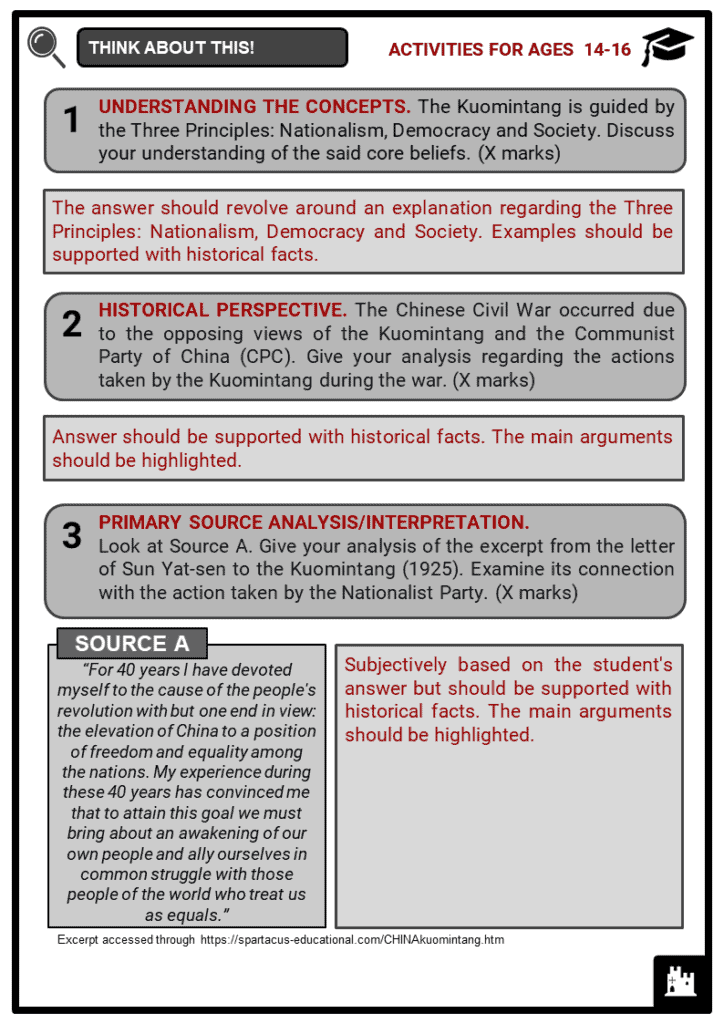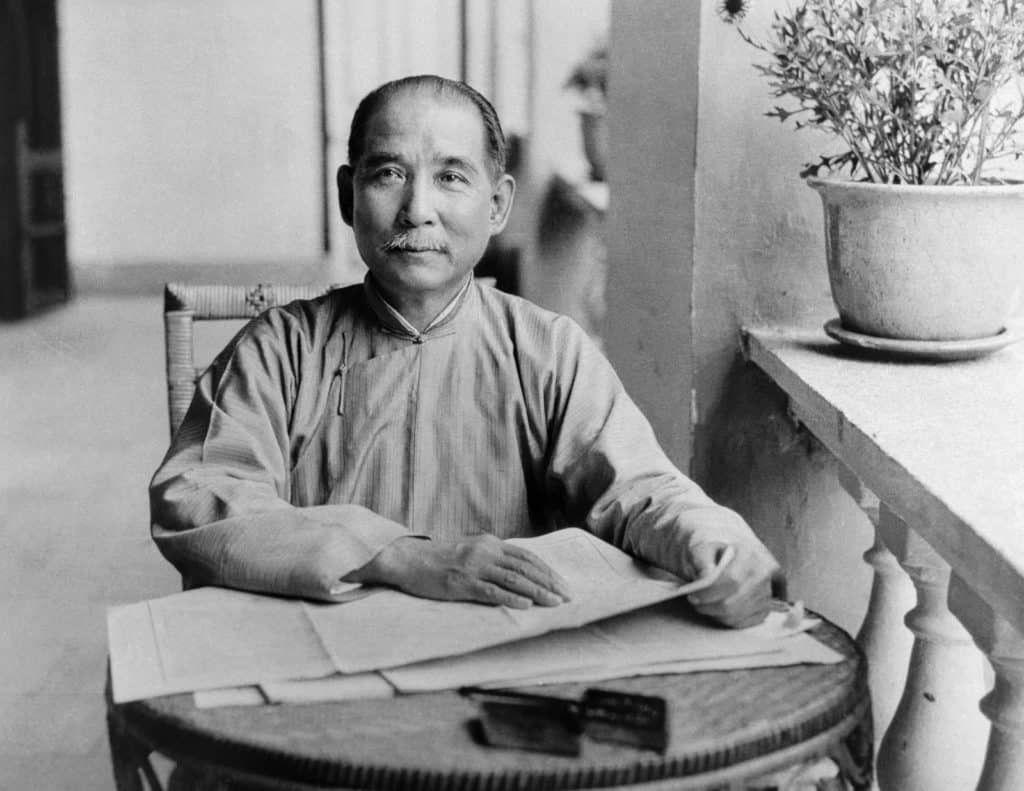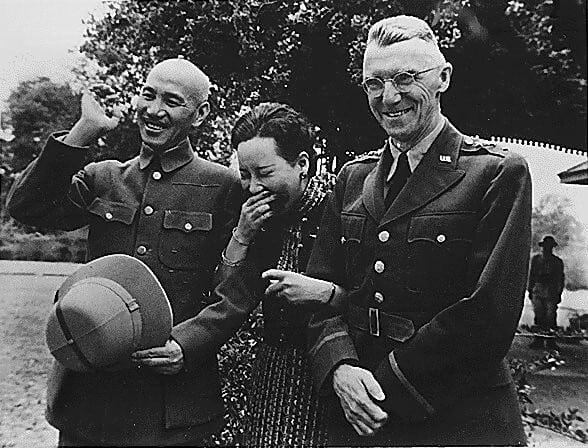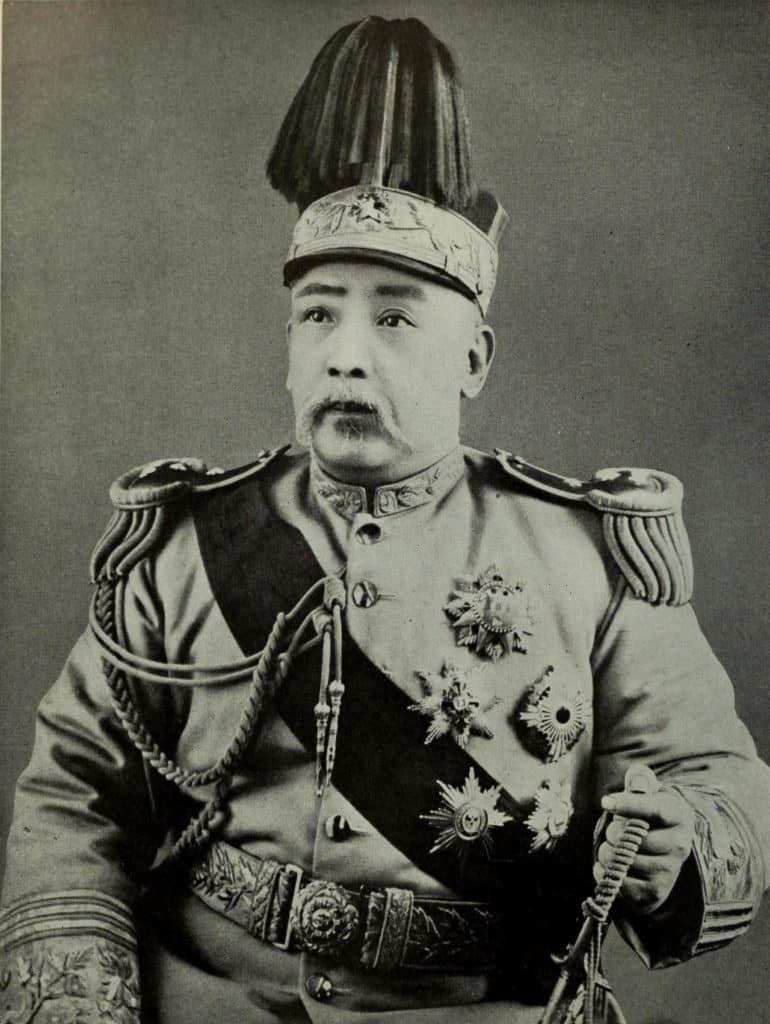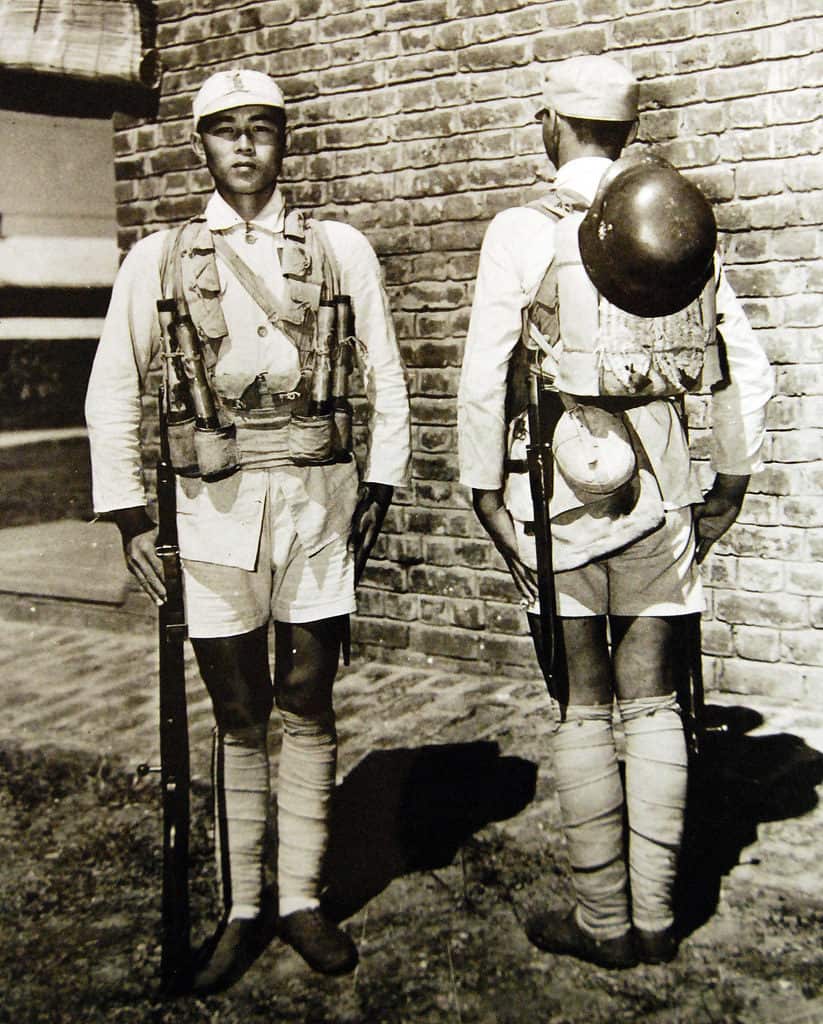Download Kuomintang (KMT), the Chinese Nationalist Party Worksheets
Do you want to save dozens of hours in time? Get your evenings and weekends back? Be able to teach Kuomintang (KMT), the Chinese Nationalist Party to your students?
Our worksheet bundle includes a fact file and printable worksheets and student activities. Perfect for both the classroom and homeschooling!
Table of Contents
Add a header to begin generating the table of contents
Summary
- The historical background of the Kuomintang
- The key people behind the Kuomintang
- The Kuomintang after the Second World War
Key Facts And Information
Let’s find out more about the Kuomintang!
- The Chinese Nationalist Party (CNP), also known as the Kuomintang (KMT; Pinyin Romanisation - Guomindang) played a significant role in overthrowing the last dynasty of China and in creating the ‘Republic of China’.
- The KMT operated under The Three Principles: Nationalism, Democracy and Society. They wanted to unify China and create a government that was operated by the people, for the benefit of the people.
- The KMT was the main opposition for the Communist Party of China (CPC), the two parties have struggled for control of China since the formation of the CPC in 1920.
- After losing the Chinese Civil War to the CPC in 1949, mainland China was declared the ‘People’s Republic of China’ (PRC). The KMT retreated to Taiwan, and it became the main headquarters of the Republic of China and the KMT.
- The KMT’s rule in Taiwan was one of two sides: strict martial law, no political freedom and a period called ‘White Terror’, as well as the ‘Taiwan Economic Miracle’ (a period of impressive economic growth).
- Despite various attempts to regain control of mainland China, the changing views of foreign nations, as well as the power of the CPC, left the KMT with no choice but to accept their position in Taiwan.
- The KMT eventually began operating democratically with the first democratic election being held in the 1990s, which the KMT won. Since then they’ve not always been as successful but the KMT has continued to be an important party in the Republic of China.
Ideology
- The KMT had a one-party policy and operated under the guidance of the Three Principles: Nationalism, Democracy and Society. This ideology was formed by one of their founders, Sun Yat-sen, and formed the core beliefs of the KMT.
- The Three Principles were as follows:
- Nationalism: Creating a united China of all ethnicities and advocating Chinese Nationalism. Also operating without any involvement from foreign powers or imperialist domination.
- Democracy: Installing a democratic government was vital to creating a united, prosperous China.
- Society: Often referred to as ‘livelihood’, this principle is slightly more difficult to define as Sun died before he could fully explain his concept and it has been debated ever since. Often referred to as social welfare, we know that it included the implementation of a land tax system which would create greater economic equality.
Leaders
- Sun Yat-sen (1866 – 1925)
- Often called the ‘Father of the Nation’ in the ROC, Sun was a philosopher and a revolutionary who played an instrumental role in modernising China and is highly revered in both China and Taiwan.
- From humble beginnings, in 1878 (aged 13) Sun moved to Honolulu, Hawaii to live with his older brother. Sun’s brother financed his education and Sun embraced it wholeheartedly, receiving awards for his academic achievements.
- In 1883, he moved back to China and went on to study medicine, although he was soon drawn to politics. He believed that the imperial system was corrupt and wanted to see a democratic China.
- Sun joined the underground revolutionaries that would eventually overthrow the Qing dynasty.
- He was the first president of the Republic of China and the first chairman of the KMT. The philosophy he developed throughout his life formed the ideology of the KMT from its outset through to the current day.
- Chiang Kai-shek (1887 – 1975)
- This is another figure who was extremely important for the development of the KMT. He had been a lieutenant for Sun Yat-sen in the Revolution and spent his life learning from Sun. Upon Sun’s death, Chiang became the leader of the KMT.
- An incredible military man, as commander-in-chief he led the National Revolution Army (NRA) in the Northern Expedition that unified China. This was followed by a period of prosperity that saw many improvements brought about by Chiang and the KMT.
- However, Chiang held an intense distrust for communism and was determined to rid China of this internal threat. After engaging in the Chinese Civil War he eventually lost mainland China to the CPC and spent the remainder of his life in Taiwan.
History
- The roots of the Kuomintang (KMT) can be seen forming towards the end of the Qing dynasty. This was China’s final imperial dynasty and one that had been plagued with problems. Issues with foreign powers had led to unequal treaties that were an embarrassment to China. Economic instability, famine and drought had led to violent civil wars.
- From 1839 onwards, there was no respite from the torrent of issues facing China and no solution from the ruling elite. The people were fed up with the inaction of the dynasty and underground resistances were formed, including the Tongmenghui led by Sun Yat-sen.
- By the beginning of the 20th century, riots, resistance and rebellions had turned into the Xinhai Revolution.
- 1912 was a significant year in Chinese history. In January, the Republic of China (ROC) was created and Sun Yat-sen was elected as the first president.
- The Qing dynasty had almost lost control and in a last-ditch attempt to subdue the revolution, command of the Beijing army had been passed to the previously exiled military and government official, Yuan Shikai. Neither Sun nor Yuan wanted a war so to try and resolve things civilly, the presidency of the ROC was ceded to Yuan under the expectation that the government would be run in a democratic fashion.
- Yuan then forced the young Emperor Puyi (age 6) to abdicate, marking the end of the Qing Dynasty’s 267-year reign.
- In August of 1912, the KMT was formed from an amalgamation of the Tongmenghui and other pro-revolution groups. Sun Yat-sen was
- chosen as the chairman and in the first democratic elections, the KMT won an impressive number of seats.
- Despite this victory, the KMT were still facing a significant problem; Yuan and the Beijing Army. In the face of ever-decreasing democratic freedom, Sun spearheaded an unsuccessful revolt known as the Second Revolution.
- Following this event, Yuan dismissed parliament and subsequently proclaimed himself as the Emperor of the Empire of China. Sun was forced to flee to Japan while many other party members were assassinated.
- After Sun’s exile, the KMT were scattered and had seemingly lost their momentum with differences regarding left-wing and right-wing views causing fractures across the party.
- Emperor Yuan died in 1916 and a new age started: the Warlord era, categorised by military rule and territorial infighting. During these years Sun quietly campaigned, keeping the KMT alive and finally returned to China and successfully re-established the KMT on 10th October 1919.
Versus Communism
- Sun was determined to unify China and could only envision that happening through military conquest. He also knew that cooperating with the newly founded Communist Party of China (CPC) would expedite this immensely.
- From 1919 onwards Sun worked tirelessly on the creation of the ROC Military Academy (previously known as the Whampoa Military Academy). After a refusal from Western powers to accept the KMT as the legitimate ruler of the ROC, Sun decided to establish a relationship with the other super-power of the day, the Soviet Union.
- In 1923, Soviet advisors arrived in China and began to restructure the KMT party in accordance with communist ideals. The advisors also trained members of the KMT on the importance and power of propaganda. Furthermore, Sun sent one of his lieutenants, Chiang Kai-shek, to Moscow to study their political and military structures.
- It was during this stay that Chiang came to the decision that communism was not a suitable structure for China, an opinion he was to hold until his final days.
- The CPC was under instructions from the Soviet Union to help the KMT in their effort to regain control of China, even encouraging them to join the KMT party while maintaining their communist ideals. This marked the start of the First United Front, also known as the first KMT-CPC alliance.
- Sun Yat-sen’s death to cancer in 1925 started a new chapter in the KMT’s history and saw a serious split emerge between the leftists and rightists. Regardless of this split, the real power of the KMT lay with Chiang Kai-shek who, as commander-in-chief, had near-total control of the NRA.
- To secure his position, Chiang Kai-shek organised the Canton-coup to rid the NRA of perceived poisonous communist influence. To keep the Soviet Union on side, he also agreed to remove extreme right-wing party members from high-ranking positions. With their alliance already at breaking point, the Northern Expedition started in July 1926 and lasted until December 1928.
- It was marred with difficulties throughout, including the commencement of the Chinese Civil War (also referred to as the Ten Year War). Despite these difficulties, it was eventually completed in two phases and culminated in the capture of the capital, Beijing.
- The following period from 1928 to 1937 is called the Nanjing Decade. This period saw some significant developments in education and transport, as well as women’s rights. It also saw more problems including the introduction of a currency system that caused hyperinflation, leaving to many internal issues.
- There was also the issue of considerable Japanese aggression. The KMT believed that to be able to fight external aggression they first needed to deal with their internal issues, the CPC.
- In 1931, the Japanese Imperial Army invaded Manchuria, the northern region of China, wherein 300,000 people were massacred.
- From 1934 Chiang attempted to exterminate or expel all communist influence from the party. The CPC was unable to withstand the force of Chiang’s persecution and retreated.
- This started an event that became known as the long march and it’s estimated that less than 10% of the CPC survived. 1936 saw a reverse of fortunes; Chiang was kidnapped and forced to ally with the CPC, marking the beginning of the second KMT-CPC United Front.
- Shortly after this second alliance was formed, in 1937 the second Sino-Japanese war began. Their alliance was often only in name and frequently the KMT and CPC ended up fighting the Japanese separately. There were claims from both parties about atrocities committed by the other. It was also during this period that national favour started to shift towards the CPC.
- The end of the second Sino-Japanese war coincided with the end of WWII and upon Japan’s surrender, allied forces ordered them to return control of seized territories back to the ROC, which included Taiwan.
- While the CPC and the KMT had tentatively allied through necessity, the end of WWII was a notable end of any alliance, as 1946 saw the recommencement of the Chinese Civil War.
- The KMT had the support of the USA while the CPC had the support of the Soviet Union. The CPC had been able to capture Japanese equipment and ammunition after the previous wars. They were also supported by the large peasant population, to whom they had promised land in return for their help in the war.
- In 1949 the CPC finally took control of China and founded the ‘People’s Republic of China’. Chiang Kai-shek had no choice but to flee to Taiwan with 2 million refugees and a few hundred thousand ROC troops.
- Chiang planned to retake mainland China from the CPC and declared Taipei the temporary capital of the Republic of China.
- The KMT had been in control of Taiwan since it had been returned by the allies in 1945. Since then the KMT had taken advantage of the island and islanders and were considered completely corrupt by the Taiwanese people.
- In 1947, an accidental shooting sparked public outrage and anti-government riots erupted across the island. Known as the 28th February Massacre (February 28 Incident), for a few weeks after the initial event, the Taiwanese people organised themselves and continued to riot, making demands of the KMT for more political freedom and representation in government.
- The KMT seemed as if they were going to cede to the demands when in fact they were just stalling for time while they awaited the arrival of further troops.
- March saw an unimaginably violent suppression of the uprising; rapes, beheadings and severe beatings were indiscriminate.
- The period after the massacre is known as ‘White Terror’. Martial law had been implemented and was used to suppress any political rivalry.
- Anyone considered a sympathiser of the communist cause would be kidnapped from the streets, often in broad daylight, to be beaten and tortured until they confessed to their crime.
- During this time people had to adhere to a strict curfew or risk being arrested or shot. This was an attempt to ensure there were no opportunities for revolutionary groups to form.
- This period of martial rule is one of the longest recorded in the world, lasting over 38 years.
- In regard to the wider world, the Republic of China had represented China at the UN since it was founded in 1949, and despite now only occupying the territory of Taiwan, the UN seat had remained occupied by the ROC.
- Due to both parties’ one-party policy, the concept of two seats at the UN was impossible and the following years saw a tug of war between the ROC and PRC over this seat. Although the support from other nations had initially been for the ROC, by 1971 the tide had turned and the majority of UN members voted for the PRC to represent China.
- The death of Chiang in 1975 and the ascension of his son Chiang Ching-kuo saw a new chapter begin. His son saw the impossibility of his father’s dream of reuniting mainland China and began instead to focus on the third principle, people’s livelihood.
- From the 1980s onwards, industrialisation and land reforms saw huge economic growth, a period known as the ‘Taiwan Economic miracle’.
- This era also saw the end of martial rule, paving the way for a democratic system and future elections. There also came a much greater focus on Taiwanese Independence.
- Upon Chiang Ching-kuo's death, he was succeeded by native Taiwanese Lee Teng-hui. He was formally elected by the National Assembly both as president of the ROC and the chairman of the KMT. He was the first person born in Taiwan to hold these positions.
- The KMT no longer had a vice-like hold over politics in Taiwan, they worked with a multitude of parties to try and create a brighter future for all the country’s citizens.
- The KMT played a significant role in shaping not only the Taiwan we know but also the China we know today.
- The Kuomintang is synonymous with the Republic of China, as the Communist Party of China is synonymous with the People’s Republic of China.
- The ROC is no longer focusing on regaining its status as ‘China’ and has been attempting to gain a seat at the UN under ‘Taiwan’. But while they are no longer fighting, the tension between the parties can be sensed in their refusal to recognise each other. At the moment the ROC does not have a seat, but hopefully one day the scars will heal and they will.
Image sources:
[1.] https://upload.wikimedia.org/wikipedia/commons/0/06/Sun_Yat-sen_1924_Guangzhou.jpg
[3.] https://upload.wikimedia.org/wikipedia/commons/4/4e/YuanShikaiPresidente1915.jpg
[4.] https://farm2.staticflickr.com/1648/23915762483_1b133928eb_b.jpg

